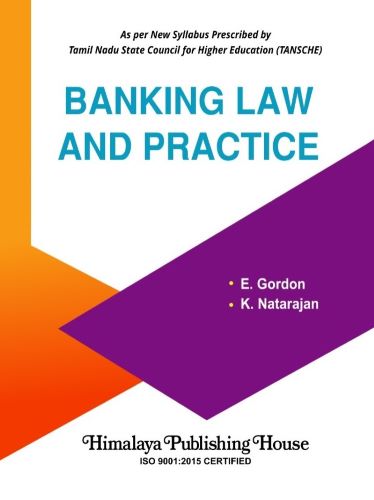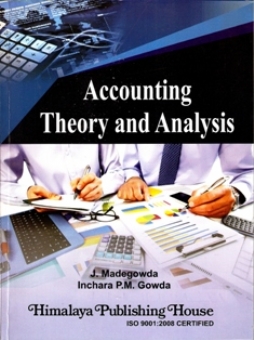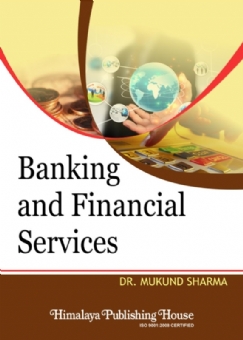Banks have a decisive role in the economic development of a country. Indian banks have become the life role of the nation and people. The banking scenario in India is changing fast to keep pace with the modern technology. The banking services, operations and practices are changing fast. The impact of modern technology has made banks to offer innumerable innovative services to customers.
There is an imperative need not only for students, but also for businessmen to have latest knowledge about banking services and practices. The objective of the book is to introduce banking as a subject to the student community in a systematic manner incorporating the latest trends in banking.
The book is written to meet the specific requirement of undergraduate commerce students of colleges in Tamil Nadu. The subject is presented in a simple and lucid style to make the readers understand the essentials of ‘Banking Law and Practice’ effectively and easily.
The book covers all the aspects given in the syllabus. It is hoped that the book will serve as an invaluable guide to achieve excellence in Banking Law and Practice.
Contents –
1. An Introduction to Banking
1.1 History of Banking
1.2 History of Banking in India
1.3 Components of Banking System
1.3.1 Financial Institutions
1.3.2 Financial Markets
1.3.3 Financial Instruments
1.3.4 Financial Services
1.4 Classification of Banks
1.4.1 Commercial Banks
1.4.2 Investment Banks or Industrial Banks
1.4.3 Exchange Banks
1.4.4 Cooperative Banks
1.4.5 Savings Banks
1.4.6 Central Bank
1.5 Banking System
1.5.1 Branch Banking
1.5.2 Unit Banking
1.5.3 Correspondent Banking System
1.5.4 Branch Banking vs. Unit Banking
1.5.5 Group Banking and Chain Banking
1.5.6 Deposit Banking vs. Mixed Banking
1.5.7 Investment Banking
1.5.8 Narrow Banking
1.5.9 Universal Banking
1.5.10 Local Area Bank
1.5.11 Offshore Banking
2. Banking Structure in India
2.1 Indigenous Bankers
2.2 Commercial Banks
2.3 Payments Banks
2.4 Small Finance Banks
2.5 Cooperative Banks
2.6 Regional Rural Banks
2.7 Foreign Banks
2.8 Private Sector Banks
2.9 Development Banks
2.9.1 Industrial Finance Corporation of India (IFCI)
2.9.2 State Financial Corporations (SFCs)
2.9.3 Industrial Development Bank of India (IDBI)
2.9.4 India Infrastructure Finance Company Limited (IIFCL)
2.9.5 Small Industries Development Bank of India (SIDBI)
2.9.6 National Bank for Agricultural and Rural Development (NABARD)
2.9.7 Export Import Bank of India (EXIM Bank)
2.9.8 National Housing Bank (NHB)
3. Banking Regulation Act, 1949
3.1 Origin of the Act
3.2 Definition of Banking
3.3 Business of Banking Company
3.4 Capital Requirements
3.5 Management
3.6 Maintenance of Liquid Assets
3.7 Licensing of Banks
3.8 Opening of New Branches
3.9 Loans and Advances
3.10 Inspection of Banks
3.11 Powers of the Reserve Bank of India
3.12 Returns to be Submitted
3.13 Acquisition of Business
3.14 Winding up of Banking Companies
3.15 Amalgamation of Banking Companies
3.16 Miscellaneous Provisions
3.17 Application of the Act to Cooperative Banks
3.18 Banking Laws (Amendment) Act, 2012
4. Commercial Banking
4.1 Definition of Banking
4.2 Functions of Commercial Banks
4.2.1 Primary Functions
4.2.1.1 Accepting Deposits
4.2.1.2 Lending Money
4.2.2 Secondary Services or Subsidiary Service
4.2.2.1 Agency Services
4.2.2.2 Miscellaneous or General Utility Services
4.3 Core Banking
4.4 Personal Banking
4.5 Corporate Banking
5. Credit Creation
5.1 Introduction
5.2 Multiple Creation of Credit
5.3 Technique of Credit Creation
5.4 Credit Contraction
5.5 Limitations of Credit Creation
6. Central Banking
6.1 Introduction
6.2 Nature of the Central Bank
6.3 Definition of a Central Bank
6.4 Functions of a Central Bank
6.4.1 Issue and Regulation of Currency
6.4.2 Banker, Agent and Adviser to the Government
6.4.3 Banker’s Bank
6.4.4 Custodian of Foreign Exchange Reserves
6.4.5 Research and Data Collection
6.4.6 Controller of Credit
6.4.6.1 Quantitative Credit Control Methods
6.4.6.1.1 Bank Rate Policy
6.4.6.1.2 Open Market Operations
6.4.6.1.3 Variable Reserve Ratio
6.4.6.2 Qualitative Methods or Selective Credit Controls
6.4.6.3 Repo Rate and Reverse Repo Rate
7. Deposits
7.1 General Precautions for Opening Accounts
7.2 Know Your Customer (KYC) Norms
7.3 Current Deposit Account (Current or Running Account)
7.4 Fixed Deposit Account
7.5 Savings Deposit account
7.6 Recurring Deposit
7.7 Jan-Dhan Yojana
8. Passbook
8.1 Introduction
8.2 Maintenance of a Passbook
8.3 Is passbook an Authentic Record?
8.4 The Position in India
8.5 E-statement
8.6 Bank Statement
8.7 Bank Statement vs. Passbook vs. E-statement
9. The Relationship between A Banker and A Customer
9.1 Customer
9.2 General Relationship
9.2.1 Not a Depository
9.2.2 Bailee
9.2.3 Trustee
9.2.4 Agent
9.2.5 Debtor Creditor Relationship
9.3 Special Relationship
9.3.1 Statutory Obligation to Honour Cheques
9.3.2 Banker’s Lien
9.3.3 Duty to Maintain Secrecy of Customer’s Accounts
9.3.4 Right to Claim Incidental Charges
9.3.5 Right to Charge Compound Interest
9.3.6 Exemption from the Law of Limitation Act
10. Bank Customers —Special Types
10.1 Introduction
10.2 Minor or Infant
10.3 A Married Woman
10.4 Lunatic
10.5 Drunkard
10.6 A Partnership Firm
10.7 A Joint Stock Company
10.8 Clubs, Societies and Non-Trading Associations
10.9 Executors, Administrators and Trustees
10.10 Joint Account
11. Loans and Advances
11.1 Introduction
11.2 Principles of Sound Lending
11.3 Secured and Unsecured Advances
11.4 Forms of Advances
11.5 Factors Influencing Lending Decision of Banks
12. Securities for Advances
12.1 Introduction
12.2 Canons of a Good Banking Security
13. Advances Against Goods
13.1 Precautions
14. Advances Against Documents of Title to Goods
14.1 Introduction
14.2 Bill of Lading
14.3 Warehouse Keeper’s Certificate/Receipt
14.4 Delivery Order
14.5 Railway Receipt
14.6 Dock Warrant
14.7 General Precautions
14.8 Precautions in the Case of Bill of Lading
14.9 Precautions in the Case of Warehouse Receipt
14.10 Precautions in the Case of Railway Receipt
14.11 Precautions in the Case of Delivery Order
14.12 Precautions in the Case of Dock Warrants
15. Advances Against Stock Exchange Securities
15.1 Introduction
15.2 Government Securities
15.3 Corporate Securities
15.3.1 Merits of Stock Exchange Securities
15.3.2 Precautions
15.4 Debentures
15.4.1 Merits
15.4.2 Precautions
16. Miscellaneous Securities
16.1 Land and Building
16.2 Life Insurance Policy
16.3 Fixed Deposit Receipt
16.4 Book Debts
16.5 Gold Ornaments
17. Banking Sector Reforms
17.1 Introduction
17.2 Income Recognition
17.3 Non-Performing Assets
17.4 Classification of Assets
17.5 Capital Adequacy Norms
17.6 Basel III Norms
18. Negotiable Instruments
18.1 Introduction
18.2 Negotiable Instruments Act
18.3 Features of Negotiable Instruments
18.4 Types of Negotiable Instruments
18.4.1 Promissory Note
18.4.2 Bill of Exchange
18.4.3 Cheque
18.4.3.1 Definitions
18.4.3.2 Distinction
18.4.3.3 Features of a cheque
18.5 Classification of Negotiable Instruments
18.6 Miscellaneous Terms
18.7 Negotiation vs. Assignment
19. Crossing
19.1 Introduction
19.2 Kinds of Crossing
19.3 Who Can Cross a Cheque?
19.4 Opening of Crossing
20. Endorsement
20.1 Introduction
20.2 Definition of Endorsement
20.3 Significance of Endorsement
20.4 Assignment vs. Endorsement
20.5 Kinds of Endorsement
20.6 Regularity of Endorsement
20.7 Other Regularities
21. Paying Banker
21.1 Introduction
21.2 Precautions before Honouring a Cheque
21.3 Circumstances for Dishonouring of Cheques
21.4 Answers to Dishonoured Cheques
21.5 Statutory Protection to Paying Banker
21.6 Payment in Due Course
21.7 Holder in Due Course
21.8 Recovery of Money Paid by Mistake
22. Collecting Banker
22.1 Introduction
22.2 Banker As a Holder for Value
22.3 Banker As an Agent
22.4 Conversion
22.5 Banker’s Liability
22.6 Statutory Protection
22.7 Basis of Negligence
22.8 Duties of Collecting Banker
23. The Banking Ombudsman Scheme, 1995
23.1 Objects of the Scheme
23.2 Appointment of Ombudsman
23.3 Powers and Duties of Banking Ombudsman
23.4 Procedure for Redressal of Grievance
23.5 Revised Scheme 2006
23.6 Revised Scheme 2009
23.7 Nature of Complaints
24. Digital Banking
24.1 Introduction
24.2 Traditional Banking vs. E-banking
24.3 Electronic Delivery Channels
24.4 Electronic Purse
24.5 Digital Banking
24.6 Electronic Cheque
24.7 Mobile Banking
24.8 Electronic Mobile Wallet
24.9 Inter-Bank Mobile Payment Service (IMPS)
24.10 Virtual Currency
24.11 Unified Payment Interface (UPI)







